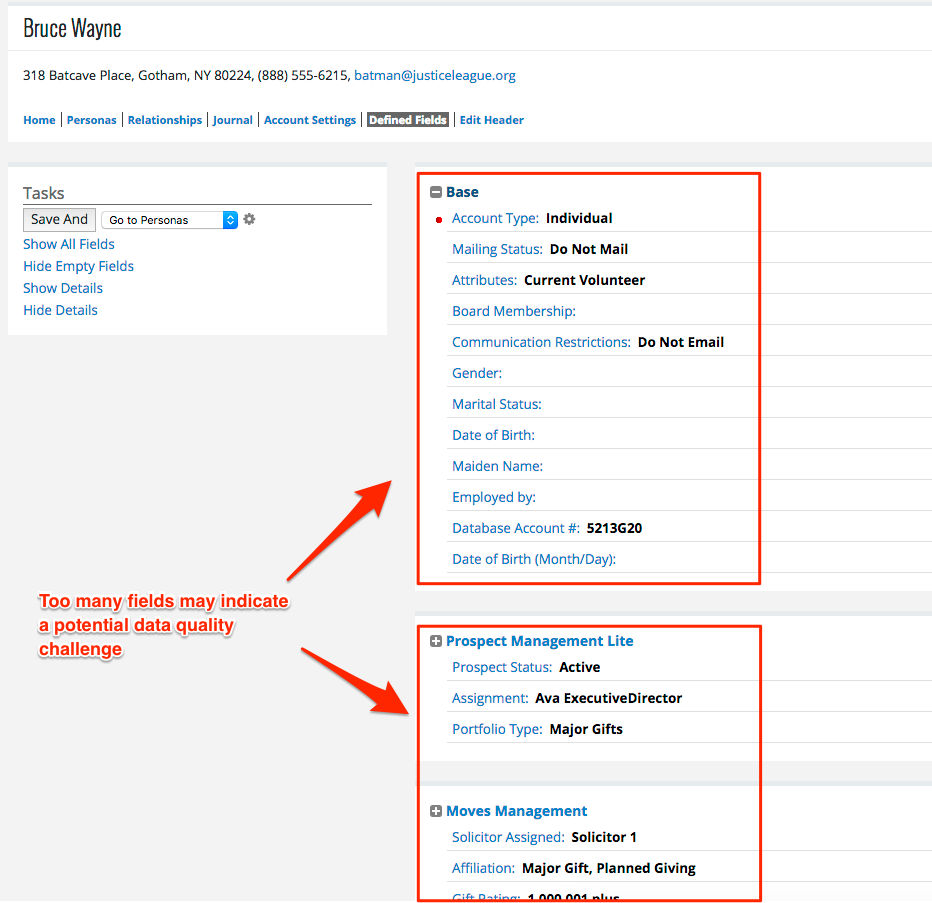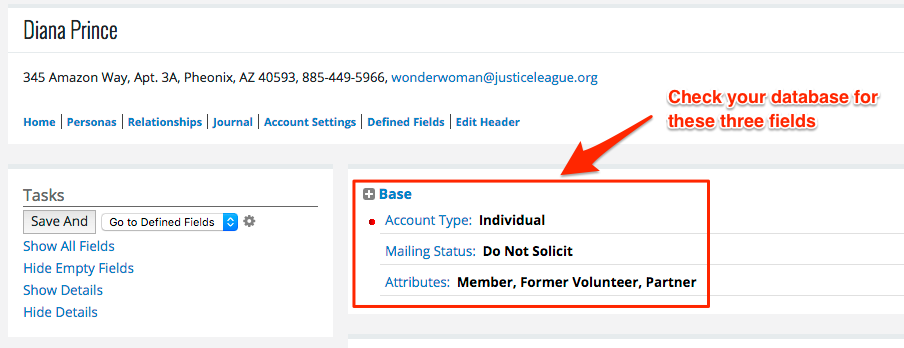eTapestry Database Audit: 6 Signs That It’s Time to Clean Up
Keeping your Blackbaud® eTapestry® database clean and healthy is a big task and knowing when to invest time, money, and energy into a database cleanup project can be a difficult decision to pinpoint. Let’s explore six signs that indicate it may be time to clean up your eTapestry database.
1. Data entry is inconsistent
All eTapestry licenses come with unlimited users. Many users in your database can lead to inconsistent data entry if you’re not careful.
Inconsistent data entry is most common with account information like names, salutations, and addresses, but can be a problem with journal entries as well.
How to identify
- Accounts use different conventions for salutations (e.g. some have titles and others don’t)
- Merging data into letters or emails requires significant data cleanup (often conducted in Excel)
- Addresses don’t follow USPS standards or you don’t run AddressFinder regularly
- Reports are difficult to interpret because data is disorganized or incomplete
- Users have no eTapestry training and there are no user guides for them to fall back on
An eTapestry database cleanup will standardize inconsistent data and guarantee accurate reports from eTapestry.
2. The account user-defined fields page is crowded
Custom user-defined fields (UDFs) expand the capability of your eTapestry software system. You can customize the data you track in eTapestry by adding UDFs to the constituent profile or specific journal entry types.
UDFs on the constituent defined fields page track preferences, demographics, and characteristics that are specific to a constituent account. The constituent defined fields page isn’t for tracking data that is date-based, like event attendance, volunteer activities, purchases, or donations.
Tracking data in UDFs on the constituent account is easy to do: building the fields is easy, data entry is easy, and reporting is easy. The simplicity with which you can track data on the constituent defined fields page often leads to eTapestry users overbuilding this page. Overbuilding leads to an overcrowded and disorganized set of UDFs.
How to identify
- Over twenty UDFs on the constituent defined fields page (with some exceptions)
- UDFs on the constituent defined fields page track date-based information that should be tracked in the journal
- Single UDFs that are multi-select checkboxes with 10-20+ values (with some exceptions)
- Accounts are missing important UDF data
- UDFs on the constituent defined fields page are hard to find and fields aren’t categorized properly

A database cleanup of the constituent defined fields page can streamline data entry so it is easier to find existing data and enter new data. A cleanup will also remove fields that are no longer needed and rearrange data so only critical fields show up.
3. Reports are inaccurate or you don’t trust the data
While minimal training on eTapestry queries and reports can lead to distrust in your data and potentially even inaccurate reports, these often signal larger data quality challenges in eTapestry.
How to identify
- Reports run from eTapestry aren’t used because staff and Board members discount their accuracy
- Reports are exported to Excel for cleanup before publishing
- You maintain external spreadsheets with important information in order to keep it clean and accurate
- Simple reports like total giving this year or total giving to a campaign, fund, or approach are consistently inaccurate and you don’t know why
Reports represent 50% of the value of eTapestry (the other 50% being data management and storage).
Inaccurate reports are essentially costing you 50% of the annual software license for eTapestry. Cleaning up your database for more accurate reporting will help you maximize return on investment (ROI) in eTapestry.
4. There are no standard rules or conventions
Almost every eTapestry software system relies on accurate coding of three user-defined fields on the constituent defined fields page.
- Account type – Identifies the entity type of the account (e.g. business, individual, foundation, etc.)
- Mailing Status – Identifies whether the account should or should not receive mail
- Attributes – Categorizes constituents into segments based on their relationship to your organization (i.e. volunteer, board member, etc.)
Some databases use other fields to segment constituents, but these are the most common. If you have no standard conventions for when and why to flag a constituent account with these custom UDFs, then you may be entering inconsistent data.
How to identify
- No user guides that detail trigger events for when to update an account
- No definitions for fields where ambiguous data entry might cause a user to incorrectly enter the data
- Segmentation fields like the ones listed above aren’t in your current database

Standard data entry procedures provide your organization an opportunity. Not only will data entry standards create more accurate reporting, but they will also future-proof your database and prepare your organization for staff transitions. New users can reference data entry standards as they learn the database, guaranteeing that your database will remain clean and healthy.
5. You identify groups of old, inactive, or unusable accounts
How do we delete old or inactive accounts from eTapestry? This is one of the most common questions from eTapestry users. There are a few options, read about them here.
The biggest challenge with old, inactive, or unusable accounts is identifying those accounts that fall into this category. These accounts might be non-donors for more than five years, accounts with no contact information, or accounts that don’t engage with your organization (i.e. they have no relevant journal entries).
These accounts weigh down your database. They aren’t contributing to your reports and they might even be increasing your mailing, marketing, and development costs.
How to identify
- You are reaching your eTapestry limit for the number of accounts in the database, and you aren’t sure about upgrading your license
- The difference between the number of constituents you send mail or email to is significantly less than the total number of accounts in your “Base – All Constituents” query
- The count of total annual donors is significantly less than the total number of accounts in your “Base – All Constituents” query

6. Excessive or disorganized data was imported from external sources
The eTapestry import feature is a universal adapter to the other technology tools that you use. If your other technology tools can export data to Excel, you can format that data to be imported into eTapestry. But data from other systems isn’t always a good fit in eTapestry.
An inaccurate or faulty import can take hours and even days to clean up. In some cases, an eTapestry import can even overwrite and severely damage data that already exists in your database.
Because imports are unrecoverable, meaning there is no way to go back in time and reset your database, overusing imports or importing data inaccurately may indicate that it’s time for an eTapestry database cleanup.
How to identify
- Data was imported into eTapestry that is rarely used or needed for any purpose
- An inaccurate import was left as is and was never cleaned up by your eTapestry database administrator
- Data in an import replaced (overwrote) the existing data in eTapestry and the data needs to be corrected
- An import was mapped to a set of fields incorrectly and the data needs to be re-mapped to the correct fields
If your database was compromised by a bad import, cleaning up your database may be a high priority.
How to conduct an eTapestry database audit
Before you start an eTapestry database cleanup, we recommend that you complete an eTapestry database audit.
An eTapestry database audit will identify the specific reasons why you might consider a database update, cleanup, or refresh. We recommend that you use this post to start the conversation and support the conclusions you make in an eTapestry database audit.
Looking for a template for your eTapestry database audit? Download our free eTapestry kit that includes an eTapestry assessment template. Follow the instructions in this free template to complete a full review of your eTapestry software system.
Free Download
The Essential Kit to eTapestry Best Practices
- 4x PDF Guides
- 1x Template/Worksheet
- 1x 60-minute Webinar
- Here we can add a benefit, or we can delete one.
Join the 700+ users that already got their kit!
DOWNLOAD NOW